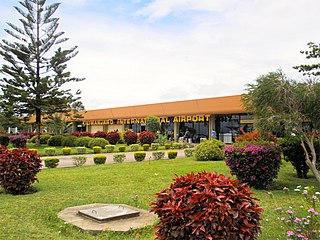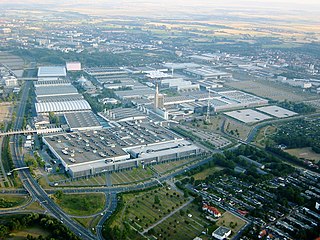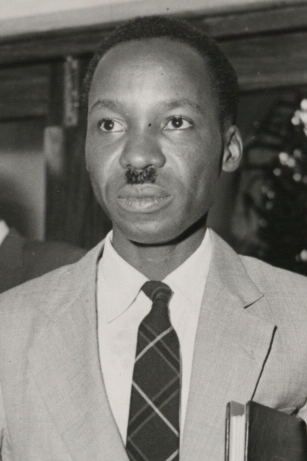Telecommunications in Tanzania include radio, television, fixed and mobile telephones, and the Internet available in mainland Tanzania and the semiautonomous Zanzibar archipelago.
Transport in Tanzania includes road, rail, air and maritime networks. The road network is 86,472 kilometres (53,731 mi) long, of which 12,786 kilometres (7,945 mi) is classified as trunk road and 21,105 kilometres (13,114 mi) as regional road. The rail network consists of 3,682 kilometres (2,288 mi) of track. Commuter rail service is in Dar es Salaam only. There are 28 airports, with Julius Nyerere International being the largest and the busiest. Ferries connect Mainland Tanzania with the islands of Zanzibar. Several other ferries are active on the countries' rivers and lakes.

Kilimanjaro International Airport (KIA) (IATA: JRO, ICAO: HTKJ) is an international airport located in Hai District, Kilimanjaro Region, Tanzania. The airport serves the cities of Arusha and Moshi. The airport handled 802,731 passengers in 2014 and mainly serves regional flights as well as a few long-haul services due to its importance as a leisure destination. It is the largest airport in northern Tanzania, by size and passenger volume.

Arusha City is a Tanzanian city and the regional capital of the Arusha Region, with a population of 2,356,255.

A convention center is a large building that is designed to hold a convention, where individuals and groups gather to promote and share common interests. Convention centers typically offer sufficient floor area to accommodate several thousand attendees. Very large venues, suitable for major trade shows, are sometimes known as exhibition halls. Convention centers typically have at least one auditorium and may also contain concert halls, lecture halls, meeting rooms, and conference rooms. Some large resort area hotels include a convention center.

Moshi is a municipality and the capital of Kilimanjaro region in the north eastern Tanzania. As of 2017, the municipality has an estimated population of 201,150 and a population density of 3,409 persons per km2. In the last official census of 2012, the municipality had a population of 184,292. The municipality is situated on the lower slopes of Mount Kilimanjaro, a dormant volcano that is the highest mountain in Africa. The name Moshi has been reported to refer to the smoke that emanates from the nearby mountain. The municipality covers about 59 square kilometres (23 sq mi) and is the smallest municipality in Tanzania by area.

The Kenyatta International Convention Centre (KICC), formerly the Kenyatta International Conference Centre, is a 28-story building located in Nairobi, Kenya. The KICC is located in the City Square of Nairobi, and is a crucial address for a number of Government offices, including those of recently elected Senators. It is an internationally renowned venue for conferences, meetings, exhibitions and special events within walking distance of several five star hotels. During its four-and-a-half-decade history it has been the host of several international conferences, seminars, exhibitions and summits.

The African Court on Human and Peoples' Rights, also known simply as the African Court, is an international court established by member states of the African Union (AU) to implement provisions of the African Charter on Human and Peoples' Rights. Seated in Arusha, Tanzania, it is the judicial arm of the AU and one of three regional human rights courts.

Arusha Urban District or Arusha City Council is one of seven administrative districts of Arusha Region in Tanzania. It is surrounded to the south, west and north by Arusha Rural District and to east by Meru District. The district covers an area of 267.0 km2 (103.1 sq mi). The district is comparable in size to the land area of Cayman Islands. The district capital is the city of Arusha. As of 1994, Arusha District was the wealthiest district in Tanzania. According to the 2012 Tanzania National Census, the population of Arusha Urban District was 416,442.

The Putrajaya International Convention Centre is the main convention centre of the Federal Territory of Putrajaya. PICC rises majestically from the top of Putrajaya's highest point in Precinct 5 and occupies an area of 135,000 square meters. The building which began construction in 2001 and was completed in September 2003, is designed by fourth prime minister Mahathir Mohamad to look like the eye of pending perak. It was renamed from the Putrajaya Convention Centre in October 2004 to its present name to reflect its international status on par with conference centres in world-class cities such London, Tokyo and Paris.

Ujamaa was a socialist ideology that formed the basis of Julius Nyerere's social and economic development policies in Tanzania after it gained independence from Britain in 1961.

The African Regional Intellectual Property Organization (ARIPO), formerly African Regional Industrial Property Organization, is an intergovernmental organization for cooperation among African states in patent and other intellectual property matters. ARIPO was established by the Lusaka Agreement of 1976. It has the capacity to hear applications for patents and registered trademarks in its member states who are parties to the Harare (patents), Banjul (marks) and Arusha protocols. ARIPO also features a protocol on the protection of traditional knowledge, the Swakopmund Protocol, signed in 2010 by 9 member states of the organization which entered into force on May 11, 2015, and was amended on December 6, 2016.
Kisongo is an administrative ward and small town in the Arusha Rural District of the Arusha Region of Tanzania. According to the 2012 census, the ward has a total population of 8,769. It is located in the outskirts of Arusha, about 7 km west of Arusha Airport. The word Kisongo comes from one of the four major Masai Clan families, Kiputiei, Loitai, Purko and Kisongo.

Sekei is an administrative ward located in Arusha District, Arusha Region of Tanzania. It is one of 19 urban administrative wards in the municipality. The name sekei comes from the Masai word seki which is a type of tree that grew there before settlement. Sekei ward was officially established in 1969. The ward is bordered by Kaloleni ward to the west, Sokon II ward to the north, Kimandolu ward to the east, Themi to the south and, a tiny portion of Kati ward to the southeast. The ward covers an area of 2.643 km2 and ranks number thirteen in the area in Arusha city. The ward is home to the East African Legislative Assembly (EALA), the Arusha International Conference Centre (AICC), and the Arusha National Museum of Natural History. Sekei is the richest ward in the city because of the large international organizations, national, and regional headquarters of various government institutions that are located there. According to the 2012 census, the ward had a total population of 9,213.
The Baháʼí Faith in Tanzania begins when the first pioneer, Claire Gung, arrived in 1950 in what was then called Tanganyika. With the first Tanganyikan to join the religion in 1952 the first Baháʼí Local Spiritual Assembly was elected in 1952 of Tanganyika in Dar es Salaam. In 1956 a regional Baháʼí Assembly which included Tanganyika was elected. Later each of the constituent countries successively formed their own independent Baháʼí National Spiritual Assembly and Tanganyika, with Zanzibar, formed its own in 1964 and it and the country was renamed Tanzania. Since 1986 the Baháʼís have operated the Ruaha Secondary School as a Baháʼí school. In 2005 Baháʼís were estimated at about 163,800 adherents.

Chennai Trade Centre is a permanent exhibition complex in Nandambakkam, Chennai, hosting several trade fairs and conventions round the year. It is the first fair infrastructure that has been developed by India Trade Promotion Organisation (ITPO)—the premier trade promotion agency of the Government of India, Ministry of Commerce and Industry—outside Delhi. A joint initiative of the ITPO and the Tamil Nadu Trade Promotion Organisation, which hold 51 and 49 percent stakes, respectively, the Trade Centre was designed by C R Narayan Rao, and was commissioned in January 2001, while the convention centre was commissioned on 1 November 2004. The exhibition hall was constructed at an estimated cost of ₹ 23 crore and the convention centre at a cost of ₹ 22 crore. Together, these centres cover 10,560 sq m and are fully booked for 75 days in a year. Built over an area of 25.48 acres, the centre comprises four modules of 4,400 m2 each of exhibition halls and support services to be built in a phased manner. In the first phase, two air-conditioned halls without pillars or columns encompassing areas of 5,000 m2 and 1,850 m2 were constructed. There are three halls, viz, Hall No. 1 (4,400 m2), Hall No. 2 (1,760 m2) and Hall No. 3 (4,400 m2). The halls feature a height of 6 m to display all merchandise including machinery. These have been supplemented recently with a modern, fully air-conditioned convention centre. All the halls are inter-linked, and Hall No. 3 is connected with the convention centre. The convention centre can accommodate 2,000 people with a provision for dividing the hall into two equal parts and has an audiovisual facility suitable for multi-purpose use such as conferences, conventions, cultural shows, and so forth. The Chennai Trade Centre is managed by Tamil Nadu Trade Promotion Organisation (TNTPO), a joint venture of ITPO and Tamil Nadu Industrial Development Corporation (TIDCO).
The Calabar International Convention Centre it's found located in Calabar, Cross River, Nigeria. It opened in the third quarter of 2015.
The Dakar Conference was a historic conference between members of the Institute for Democratic Alternatives in South Africa (IDASA) and the African National Congress (ANC). It was held in Dakar, Senegal between 9 and 12 July 1987. The conference discussed topics such as strategies for bringing fundamental change in South Africa, national unity, structures of the government and the future of the economy in a free South Africa. The IDASA delegation from South Africa, participated in the conference in their private capacity and would later be condemned by the South African government for meeting a banned organization. The future indirect result of the conference was South African government talks with Nelson Mandela and his eventual meeting with P. W. Botha in 1989.















